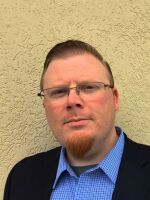The University of Akron has had a new president for about a month. Scott Scarborough started July 1, moving from the University of Toledo. Ideastream's Tony Ganzer had a wide-ranging talk with him late last week, touching on higher education trends and cost pressures. Ganzer asked his views on university budgets being dominated by administrative costs, and investments in shiny new buildings, while the faculty was more dominated by part-time adjunct staffers.
SCARBOROUGH: “If you look at the trend line since 1970, the percentage of tenured and tenure-track faculty is on the decline all over the country, and that is primarily economically driven. At some point there is a floor at which you can’t go beneath. Now the good thing about that is that if you get the mix right, the idea of a tenured or tenure-track faculty who is on the cutting-edge of their field, balanced with a person who is primarily working full-time in industry and who is a part-time instructor, can give the student a nice blend between expert researcher and applied practitioner. In terms of the nice new buildings, again it is a competitive marketplace. Students have many, many choices, and they’re going to want to come to an institution that has the facilities and equipment that help support the kind of higher education that they believe that they need.”
GANZER: “You were talking about students having the choice, and institutions having to remain competitive. I’m curious at what point does it make sense that universities need to just work closer together instead of investing all on their own. Kent State of course very close to Akron, is there kind of a natural synergy, to use jargon?”
SCARBOROUGH: “Yeah, I think that it’s not necessarily inconsistent to say that it’s a competitive market and it’s also a cooperative market, meaning: the idea of being competitive really is saying ‘be the best version of yourself.’ You can do that and at the same time cooperate with the institutions in your area. And it does produce institutions that are different in some important way. I think most people would recognize that the strength in the University of Akron is its engineering and science programs, and its professional programs, and they might attribute a different strength to an institution like Kent State or Cleveland State, which may have more of a liberal arts, undergraduate reputation. So I think all institutions carve out the niche, and they all compete, or purpose and work hard to become the best version of that institution. ”
GANZER: “It’s not just unique to Akron, but all over, especially Humanities programs are under cost pressures, and I know there is push-back, we see this every once in a while, to university president salaries. I see here in a report you’re making $450,000 a year, plus bonuses. What do you say to people who say a public university president should not be making that much?”
SCARBOROUGH: “Well, we have labor markets that have competitive pressures, and what we end up paying a faculty member in the college of business is very different than what we pay a faculty member in the history department. That’s simply because there’s a different market for business professors than there is for history professors, and it’s the same thing is true for administration. There is a market for those who choose to administer universities and each one of those markets commands a different type of pay scale. That’s the way it has always been in this country, and I don’t know if it’s going to change any time soon, so that’s going to be a challenge for the foreseeable future.”
GANZER: “You’re going through your review of the institution, but do you have any ideas yet what a project for you will be coming up?”
SCARBOROUGH: “Part of this first 90 days is really to listen more than to make decisions at this point, but having said that, a general principle that one will probably employ is to build on existing strengths. You want to take what you do well, what you are known for, and see if there’s a way to take that to a higher level and to a broader market. I need to compile a list of our existing strengths, and then ask the question, ‘okay, how can we build on those strengths.’”




